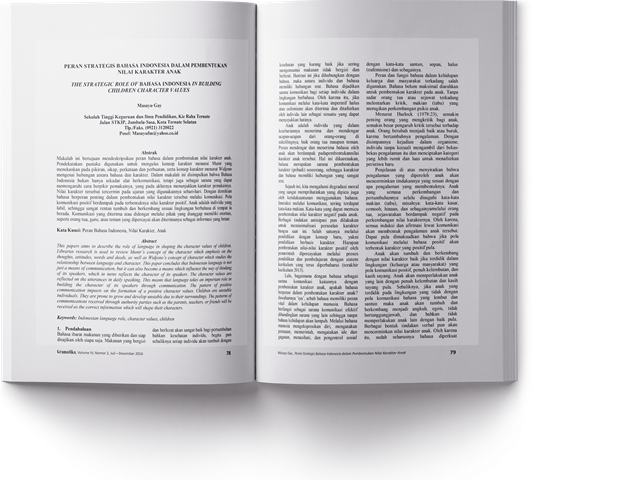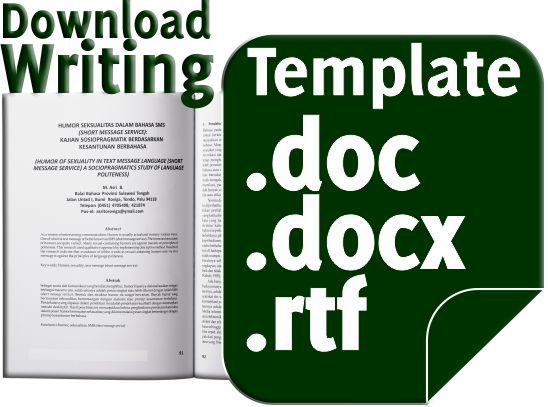The Strategic Role of Bahasa Indonesia in Building Children Character Values
Abstract
This papers aims to describe the role of language in shaping the character values of children. Libraries research is used to review Munir’s concept of the character which emphasis on the thoughts, attitudes, words and deeds, as well as Widjono’s concept of character which studies the relationship between language and character. This paper concludes that Indonesian language is not just a means of communication, but it can also become a means which influence the way of thinking of its speakers, which in turns reflects the character of its speakers. The character values are reflected on the utterances in daily speaking. This means that language takes an important role in building the character of its speakers through communication. The pattern of positive communication impacts on the formation of a positive character values. Children are unstable individuals. They are prone to grow and develop unstable due to their surroundings. The patterns of communications received through authority parties such as the parents, teachers, or friends will be received as the correct information which will shape their characters.
References
Almatin, I. 2010. Dahsyatnya Hipnosis Learning untuk Guru dan Orang Tua. Yogyakarta: Pustaka Widyatama.
Anwar, H. 1995. Beberapa Aspek Soiso-Kultural Masalah Bahasa. Yogyakarta: Gajah Mada University Press.
Bariqoh, A. 2015. “Ekranasi Film Biopic: Penanaman Nilai Semboyan “Jas Merah” sebagai Usaha Pembentukan Karakter Mahasiswa STKIP PGRI Sampang”. Prosiding Seminar International Riksa Bahasa IX. 26 November 2015, Bandung, Indonesia. Hal. 260.
Bickerton, Derek.1992. Language & Species. Chicago: University of Chicago Press.
Budiningsi, Asri, C. 2005. Belajar dan Pembelajaran. Jakarta: PT Rinek Cipta.
Corballis, M. C. 2011. The Recursive Mind: The Origins of Human Language, Thought, andCivilization. Princeton, New Jersey: Princeton University Press.
Hurlock, B. E. 1987. Perkembangan Anak. Jakarta: Erlangga.
Jenkins, Lyle. 2000. Biolinguistics: ExploringtheBiology of Language. Cambridge: CambridgeUniversity Press.
Julian M., James dan John Alfred. 2008. Belajar Kepribadian. Yogyakarta: Penerbit BACA.
Moeliono, A. M. dkk. 2003. Kamus Besar Indonesia. Jakarta: Balai Pustaka.
Moeliono, A. M. 2003. Tata Bahasa Baku Bahasa Indonesia. Jakarta: Balai Pustaka.
Munir, A. 2010. Pendidikan Karakter Membangun Karakter Anak Sejak dari Rumah. Yogyakarta: Pustaka Insan Madani.
Pamungkas, S. 2012. Bahasa Indonesia dalam Berbagai Perspektif. Yogyakarta: Andi.
Pranowo. 2009. Berbahasa Secara Santun. Yogyakarta: Pustaka Pelajar:
Refmianti, dkk. 2012. “Ungkapan Makian Bahasa Minangkabau di Kenagarian Taluk Kecamatan Lintou Buo Kabupaten Tanah Datar”. Jurnal Pendidikan Bahasa dan Sastra Indonesia. Vol. 1 (1): 381.
Smit, Harry. 2014. The Social Evolution of Human Nature; From Biology to Language. Cambridge: Cambridge University Press.
Sudaryat, Y. 2009. Makna dalam Wacana. Bandung: Yrama Widya.
Suryatin, E. 2011. Bunga Rampai: Hasil Penelitian Kebahasaan. Kalimantan Selatan: Balai Bahasa Banjarmasin.
Vossler, Karl. 2014. The Spirit of Languagein Civilization. [1932]. Oxford and New York: Rautledge.
Wardhaugh, Ronald, and Fuller, Janet M. 2015. An Introductionto Sociolinguistics. Seventhedition. Malden, MA & Oxford: Wiley-Blackwell.
Wiarto, Edi, D., dkk. 2010. Pendidikan Karakter: Kumpulan Pengalaman Inspiratif. Jakarta: Kementerian Pendidikan Nasional Indonesia.
Widjono. 2012. Bahasa Indonesia: Mata Kuliah Pengembangan Kepribadian di Pergutuan Tinggi. Jakarta: PT Grasindo.
Yu, Xing. 2013. Languageand State: and Inquiry Into the Progress of Civilization. Lanham, Maryland & Plymouth, UK: University Press of America.

Copyright (c) 2016 Masayu Gay

This work is licensed under a Creative Commons Attribution-NonCommercial-ShareAlike 4.0 International License.


